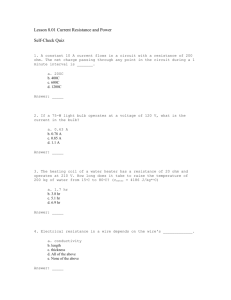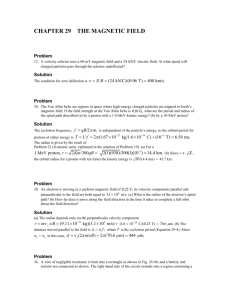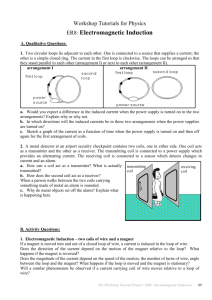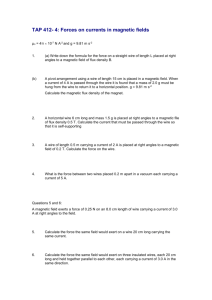冉 冊 ␣
advertisement
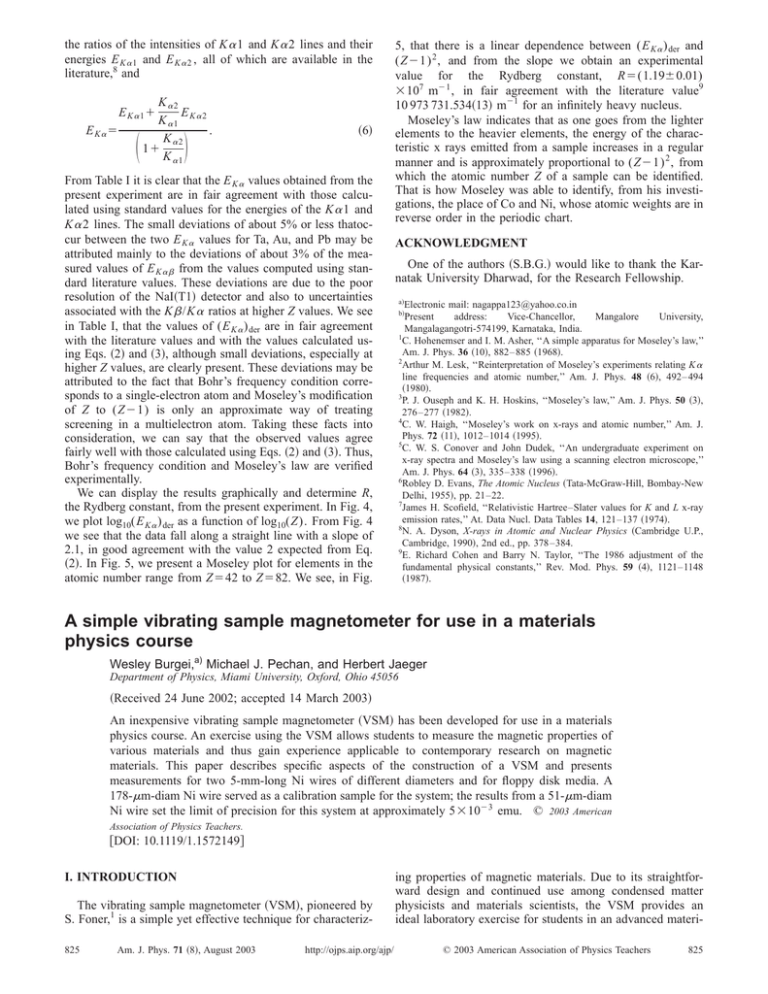
the ratios of the intensities of K ␣ 1 and K ␣ 2 lines and their energies E K ␣ 1 and E K ␣ 2 , all of which are available in the literature,8 and K ␣2 E K ␣1 K␣2 . K ␣2 1⫹ K ␣1 E K␣1⫹ E K␣⫽ 冉 冊 共6兲 From Table I it is clear that the E K ␣ values obtained from the present experiment are in fair agreement with those calculated using standard values for the energies of the K ␣ 1 and K ␣ 2 lines. The small deviations of about 5% or less thatoccur between the two E K ␣ values for Ta, Au, and Pb may be attributed mainly to the deviations of about 3% of the measured values of E K ␣ from the values computed using standard literature values. These deviations are due to the poor resolution of the NaI共T1兲 detector and also to uncertainties associated with the K  /K ␣ ratios at higher Z values. We see in Table I, that the values of (E K ␣ ) der are in fair agreement with the literature values and with the values calculated using Eqs. 共2兲 and 共3兲, although small deviations, especially at higher Z values, are clearly present. These deviations may be attributed to the fact that Bohr’s frequency condition corresponds to a single-electron atom and Moseley’s modification of Z to (Z⫺1) is only an approximate way of treating screening in a multielectron atom. Taking these facts into consideration, we can say that the observed values agree fairly well with those calculated using Eqs. 共2兲 and 共3兲. Thus, Bohr’s frequency condition and Moseley’s law are verified experimentally. We can display the results graphically and determine R, the Rydberg constant, from the present experiment. In Fig. 4, we plot log10(E K ␣ ) der as a function of log10(Z). From Fig. 4 we see that the data fall along a straight line with a slope of 2.1, in good agreement with the value 2 expected from Eq. 共2兲. In Fig. 5, we present a Moseley plot for elements in the atomic number range from Z⫽42 to Z⫽82. We see, in Fig. 5, that there is a linear dependence between (E K ␣ ) der and (Z⫺1) 2 , and from the slope we obtain an experimental value for the Rydberg constant, R⫽(1.19⫾0.01) ⫻107 m⫺1 , in fair agreement with the literature value9 10 973 731.534共13兲 m⫺1 for an infinitely heavy nucleus. Moseley’s law indicates that as one goes from the lighter elements to the heavier elements, the energy of the characteristic x rays emitted from a sample increases in a regular manner and is approximately proportional to (Z⫺1) 2 , from which the atomic number Z of a sample can be identified. That is how Moseley was able to identify, from his investigations, the place of Co and Ni, whose atomic weights are in reverse order in the periodic chart. ACKNOWLEDGMENT One of the authors 共S.B.G.兲 would like to thank the Karnatak University Dharwad, for the Research Fellowship. a兲 Electronic mail: nagappa123@yahoo.co.in Present address: Vice-Chancellor, Mangalore University, Mangalagangotri-574199, Karnataka, India. 1 C. Hohenemser and I. M. Asher, ‘‘A simple apparatus for Moseley’s law,’’ Am. J. Phys. 36 共10兲, 882– 885 共1968兲. 2 Arthur M. Lesk, ‘‘Reinterpretation of Moseley’s experiments relating K ␣ line frequencies and atomic number,’’ Am. J. Phys. 48 共6兲, 492– 494 共1980兲. 3 P. J. Ouseph and K. H. Hoskins, ‘‘Moseley’s law,’’ Am. J. Phys. 50 共3兲, 276 –277 共1982兲. 4 C. W. Haigh, ‘‘Moseley’s work on x-rays and atomic number,’’ Am. J. Phys. 72 共11兲, 1012–1014 共1995兲. 5 C. W. S. Conover and John Dudek, ‘‘An undergraduate experiment on x-ray spectra and Moseley’s law using a scanning electron microscope,’’ Am. J. Phys. 64 共3兲, 335–338 共1996兲. 6 Robley D. Evans, The Atomic Nucleus 共Tata-McGraw-Hill, Bombay-New Delhi, 1955兲, pp. 21–22. 7 James H. Scofield, ‘‘Relativistic Hartree–Slater values for K and L x-ray emission rates,’’ At. Data Nucl. Data Tables 14, 121–137 共1974兲. 8 N. A. Dyson, X-rays in Atomic and Nuclear Physics 共Cambridge U.P., Cambridge, 1990兲, 2nd ed., pp. 378 –384. 9 E. Richard Cohen and Barry N. Taylor, ‘‘The 1986 adjustment of the fundamental physical constants,’’ Rev. Mod. Phys. 59 共4兲, 1121–1148 共1987兲. b兲 A simple vibrating sample magnetometer for use in a materials physics course Wesley Burgei,a) Michael J. Pechan, and Herbert Jaeger Department of Physics, Miami University, Oxford, Ohio 45056 共Received 24 June 2002; accepted 14 March 2003兲 An inexpensive vibrating sample magnetometer 共VSM兲 has been developed for use in a materials physics course. An exercise using the VSM allows students to measure the magnetic properties of various materials and thus gain experience applicable to contemporary research on magnetic materials. This paper describes specific aspects of the construction of a VSM and presents measurements for two 5-mm-long Ni wires of different diameters and for floppy disk media. A 178-m-diam Ni wire served as a calibration sample for the system; the results from a 51-m-diam Ni wire set the limit of precision for this system at approximately 5⫻10⫺3 emu. © 2003 American Association of Physics Teachers. 关DOI: 10.1119/1.1572149兴 I. INTRODUCTION The vibrating sample magnetometer 共VSM兲, pioneered by S. Foner,1 is a simple yet effective technique for characteriz825 Am. J. Phys. 71 共8兲, August 2003 http://ojps.aip.org/ajp/ ing properties of magnetic materials. Due to its straightforward design and continued use among condensed matter physicists and materials scientists, the VSM provides an ideal laboratory exercise for students in an advanced materi© 2003 American Association of Physics Teachers 825 Fig. 1. Schematic diagram of the VSM apparatus showing: 共1兲 coil measurement signal path from the lock-in to LabVIEW via GPIB, 共2兲 signal from the detection coils, 共3兲 driving signal from the lock-in to the mechanical vibrator, 共4兲 the power supply connection to the magnet, 共5兲 the power supply control signal from LabVIEW, 共6兲 the Hall-probe input to LabVIEW via the DAC, 共7兲 mechanical vibrator, 共8兲 electromagnet, 共9兲 magnet pole pieces, 共10兲 detection coil, 共11兲 drinking straw shaft, and 共12兲 Hall probe. als physics course. This setup allows exploration of a common experimental technique for measuring magnetic material properties such as hysteresis, saturation, coercivity, and anisotropy. The VSM is one of a number of techniques illustrated in our materials physics laboratory course2 that emphasizes measurement and characterization of various materials. Based on Faraday’s law of induction, the VSM relies on the detection of the emf induced in a coil of wire given by Fig. 2. Photograph of the VSM showing: 共1兲 sense coils, 共2兲 acetal sample mount covered in parafilm, 共3兲 banana plug connector, 共4兲 soda straw sample rod, and 共5兲 magnet pole pieces. The solenoid axis of each sense coil is oriented parallel to the sample rod. II. APPARATUS The layout of our VSM is depicted schematically in Fig. 1, and a photograph of the sample rod and pickup coil area is shown in Fig. 2. A. Oscillating sample mount d ⫽⫺N 共 BA cos 兲 , dt 共1兲 where N is the number of wire turns in the coil, A is the coil turn area, and is the angle between the B field and the direction normal to the coil surface. In practice, knowledge of coil parameters such as N and A is unnecessary if the system can be calibrated with a known sample. The operation of the VSM is fairly simple. A magnetic sample is placed on a long rod and then driven by a mechanical vibrator. The rod is positioned between the pole pieces of an electromagnet, to which detection coils have been mounted. The oscillatory motion of the magnetized sample will induce a voltage in the detection coils. The induced voltage is proportional to the sample’s magnetization, which can be varied by changing the dc magnetic field produced by the electromagnet. This article focuses on the construction and operation of a relatively inexpensive VSM for a materials physics course. The construction could also serve as a student project. Other than a commercial lock-in amplifier, a variable dc power supply, and a small electromagnet, only inexpensive and readily available components are required for implementation in a teaching laboratory. 826 Am. J. Phys., Vol. 71, No. 8, August 2003 Sample oscillation is provided by a Pasco Scientific Model SF-9324 mechanical drive that is mounted to an x – y – z translator3 so that the sample can be centered easily between the magnet poles. The shaft of the sample mount is a long clear drinking straw, which is tightly fitted to the bottom of the mechanical vibrator by a banana plug. We have found that for the intended purposes, the drinking straw provides enough strength and rigidity; however, one could also use a mechanical guide to prevent excess nonaxial motion. An acetal cylinder was machined and fitted inside the bottom of the drinking straw to provide a sample mount. The sample can be fastened with either vacuum grease or a small piece of Parafilm® , the latter being used in our case since the small pole pieces and wide gap produced significant field gradients tending to dislodge the sample. To correct for small variations in vibration amplitude and frequency with time, a reference coil and magnet are often used in research-grade investigations, but they are not employed in the present apparatus. B. Experimental magnetic field An air-cooled GMW® Model 3470 electromagnet with 45mm-diam pole pieces provides the external applied field. The Apparatus and Demonstration Notes 826 C. Signal detection Fig. 3. Hysteresis loop for a Ni wire sample of 5-mm length and 178-m diameter. This sample is used for magnetization calibration. 关To convert to SI units, use 1 oersted (Oe)⫽(103 /4 )(A/m)]. magnet is powered by a voltage-controlled Kepco® 36V/6A bipolar power supply. The magnetic field is measured by an F.W. Bell® Model 5080 Gauss-meter with analog output capabilities; its Hall probe is mounted between the magnet pole pieces close to the sample position. The electromagnet is attached to a rotating base, which consists of a lazy-susantype ball bearing rotator and a circular wooden base. This feature allows measurements to be made as a function of angle. As mentioned above, the combination of the small pole-piece diameter and the wide gap necessary to accommodate the detection coils yields a significant magnetic field gradient in the sample region. The field gradient adds noise to the system by introducing a force on the sample that creates nonaxial motion of the straw shaft. The most important component that determines the system’s resolution is the pick-up coil assembly. While commercial pick-up coils would, of course, provide the highest sensitivity, satisfactory results can be obtained using coils extracted from electro-mechanical relays. In our case, two 32k coils were removed from electromechanical relays;4 each coil had an axial length of 18 mm and outer radius of approximately 12 mm. The iron cores of the coils were left in place to increase sensitivity. Each coil was attached with mounting wax to a printed circuit board that was etched with pads for the coil leads and for the coaxial cable running to the lock-in amplifier. The printed circuit board was then attached to the magnet pole pieces so that the cylindrical axis of each pick-up coil was collinear to and coplanar with the axis of sample vibration. The coils are wired so that their induced emfs sum. Since we are measuring an ac signal and desire to optimize signal-to-noise, we use synchronous detection. We use a Stanford Research Systems Model SR830 lock-in amplifier, which is set to lock-on to a signal oscillating at the driving frequency. We use the lock-in amplifier to provide a signal that drives the mechanical vibrator and also serves as the reference signal for the lock-in; however, one could just as easily use a separate function generator for the driving signal and provide it to the lock-in amplifier as a reference signal. It should be noted that if a commercial lock-in amplifier is not available, a less flexible substitute may be constructed using an Analog Devices AD630 balanced mod/demod IC and Burr-Brown’s 4423 quadrature oscillator.5 D. Automated data collection A LabVIEW™ program provides experimental control and data acquisition. The program produces a calibrated analog signal, through a National Instruments Model 6024A data acquisition card 共DAQ兲, which sets the current of the power supply so as to provide the desired magnetic field. The program then sweeps the field from high to low, and then back to high, in steps determined by the user. At each field setting, the induced signal read by the lock-in amplifier is transferred to the computer through the GPIB bus, and the output of the Hall probe is measured through the DAQ. Once the program completes a field cycle, the data are plotted and saved to a text file. All measurements could just as well be made using the DAQ card and analog outputs from the instruments. III. RESULTS Fig. 4. Hysteresis loop for a Ni wire sample of 5-mm length and 51-m diameter. This measurement demonstrates the lower level of precision for this system. 827 Am. J. Phys., Vol. 71, No. 8, August 2003 In our materials physics course, three samples are used to illustrate the VSM technique. Figure 3 shows data from a 5-mm length of 178-m-diam Ni wire6 used for signal calibration. An external field, applied parallel to the sample length, is swept through a complete cycle in order to record a hysteresis loop. Then, using the known Ni magnetization,7 500 emu/cm3, and the known wire volume, we can convert the high field voltage signal 共where the magnetization is saturated兲 into emu units.8 共To convert to SI units, use 1 emu/cm3 ⫽103 A/m.) Figure 4 shows data from a 5-mm length of 51-m-diam Ni wire 共also with its length parallel to the applied field兲 that demonstrates the lower limit of resolution of this system is about 5⫻10⫺3 emu with a signal-tonoise ratio of 3:1. Despite the low signal-to-noise ratio, the magnetic moment of this sample is consistent with that of the Apparatus and Demonstration Notes 827 The third sample examined is floppy disk material cut using a hole-punch to make circular pieces with a diameter of 5 mm. Five pieces were stacked together and measurements made with the magnetic field parallel to the planes of the disks. This stack provides a large signal with a good signalto-noise ratio, as seen in Fig. 5. The resulting hysteresis loop is wide with a relatively high coercivity that is typical of magnetic storage materials. The oscillatory noise at higher fields is due to transverse motion of the sample rod induced by the field gradient. One could easily investigate the magnetic properties of other readily available samples such as small pieces of paper clip or iron filings. IV. SUMMARY Fig. 5. Hysteresis loop for 5-mm-diameter circular pieces of floppy disk material. Five pieces were stacked together. 178-m Ni wire if the difference in volume of the two wires is taken into account. Both Ni wire samples exhibit approximately the same coercive field, which is defined as the field producing zero magnetization upon reversal. However, the remnant field—the magnetization in zero field—is quite different for the two. The 51-m-diam Ni wire is characterized by a square loop with high remnance, implying it has a very abrupt magnetization reversal, whereas the 178-m sample has lower remnance, consistent with a more gradual reversal process. These results are consistent with shape anisotropy arising from demagnetization effects in a rod-like sample.9 Since the length-to-diameter aspect ratio is 3.5 times greater for the 51-m wire, the shape anisotropy is much greater and therefore more effective in keeping the magnetization along the long axis of the wire. This anisotropy is competing with the randomly oriented crystalline anisotropies associated with the polycrystalline nature of the wire. In the thin wire, the shape anisotropy dominates, whereas in the thick wire, the effect of the randomly oriented crystallites is more evident. 828 Am. J. Phys., Vol. 71, No. 8, August 2003 The construction and operation of an inexpensive VSM for a materials physics course has been described in detail. Ni wire and floppy disk samples were examined, and, with a magnetization resolution of about 5⫻10⫺3 emu, this simple VSM provided results that illustrated basic properties of magnetic materials and were suitable for quantitative analysis. a兲 Electronic mail: burgeiwa@muohio.edu S. Foner, ‘‘Versatile and Sensitive Vibrating-Sample Magnetometer,’’ Rev. Sci. Instrum. 30 共7兲, 548 –557 共1959兲. 2 H. Jaeger, M. J. Pechan, and D. K. Lottis, ‘‘Materials physics: A new contemporary undergraduate laboratory,’’ Am. J. Phys. 66 共8兲, 724 –730 共1998兲. 3 Parts 5200 and 1185, Sherline Products, Inc., 3235 Executive Ridge, Vista, CA 92083-8527. 4 Part #RTB14730, Schrack Energietechnik GmbH, Seybelgasse 13, 1235 Wien, Austria. 5 M. J. Pechan, J. Xu, and L. D. Johnson, ‘‘Automatic frequency control for solid-state sources in electron spin resonance,’’ Rev. Sci. Instrum. 63 共7兲, 3666 共1992兲. 6 California Fine Wire Company, 338 So. Fourth Street, Grover Beach, CA 93433-0199. 7 Charles Kittel, Introduction to Solid State Physics 共Wiley, New York, 1986兲, 6th ed., p. 429. 8 B. D. Cullity, Introduction to Magnetic Materials 共Addison–Wesley, Reading, MA, 1972兲, p. 7. 9 Reference 8, p. 240. 1 Apparatus and Demonstration Notes 828



